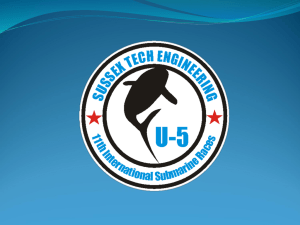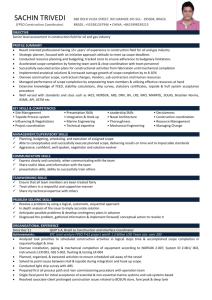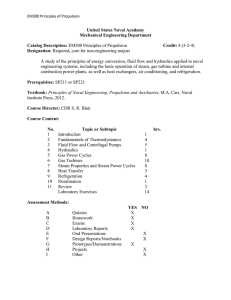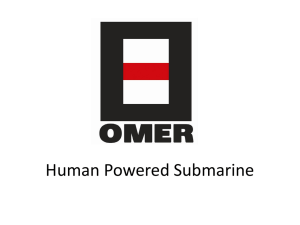M.Sc. Marine Engineering Ship Design Exercise 2000 Department of Mechanical Engineering
advertisement
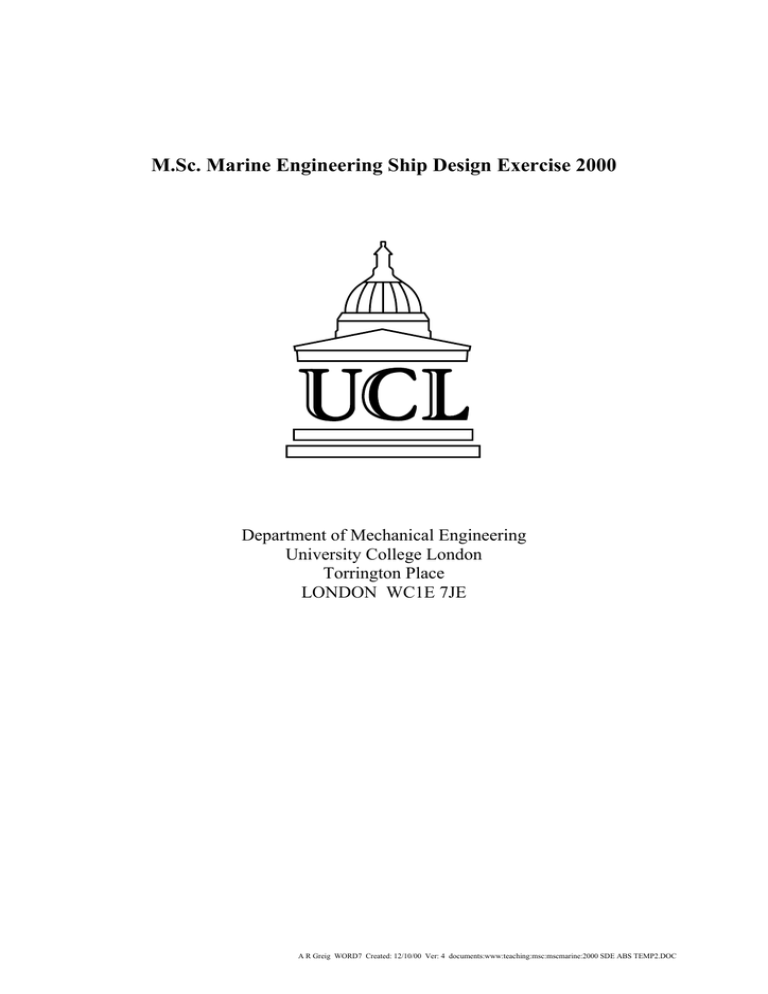
M.Sc. Marine Engineering Ship Design Exercise 2000 Department of Mechanical Engineering University College London Torrington Place LONDON WC1E 7JE A R Greig WORD7 Created: 12/10/00 Ver: 4 documents:www:teaching:msc:mscmarine:2000 SDE ABS TEMP2.DOC Marine Engineering SDE Abstracts 2000 INDEX No. Design Students 5 MULTIROLE MONOHULL WARSHIP S May, ME (M) 6 MULTIROLE TRIMARAN WARSHIP Lt D J M Doull RN, ME(L) Lt Cdr P Terblanche SAN, ME(M) (Pentamaran Configuration) H Bullen, NA P Kulkarni, NA M Pegrum MOD, NA Lt H Khalid PN, NA 7 FAST EXPORT CORVETTE, (Monohull) Lt M J Rand RN ME(M) 8 TRISWACH GENERAL PURPOSE FRIGATE Lt J P Burvill RN, MSc ME(M) Lt B T Thorp RN, MSc ME(L) Lt Cdr CG Teo RSingN NA R Boulby, NA T Stiven, NA 2 Marine Engineering SDE Abstracts 2000 MULTIROLE MONOHULL WARSHIP GROUP 5: 2000 S May, MSc Marine Engineering (Mechanical Option) H Bullen, MSc Naval Architecture P Kulkarni, MSc Naval Architecture Introduction The Strategic Defence Review emphasised that Forces within the United Kingdom must be flexible and be able to deal with global problems rapidly. The Forces must be manned, equipped, trained and supported by modern warfare. Operations are likely to be multinational and involve the deployment of forces over considerable distances. The Royal Navy has a requirement for a ship to carry out multipurpose missions in both open ocean and coastal water areas. When operating close to shore the ship must have an enhanced survivability capability as well as operating in areas of high submarine threat. Threat The threat to the ship can be classified into two sections, open ocean and coastal waters. The open ocean threats are well known to the Royal Navy and are based on the Cold War doctrine that utilises a strike carrier group as its centrepiece. The Multirole Monohull Warship (MMW) must be able to integrate within a Battle Group and provide Anti Submarine Warfare (ASW), Anti Surface Warfare (ASuW) and Anti Air Warfare (AAW) protection. The relatively new concept of operating in coastal waters poses new problems. There are a number of new threats from land attack. These are inshore mines, fighter aircraft, attack helicopters, coastal batteries and small patrol boats. The ships sensors will need to cope with additional clutter and its systems must be able to respond to rapid information gathering and target the enemy swiftly. Tasks The tasks of the MMW are as follows. a. Prosecute long range inland targets. b. Support tactical amphibious landings. c. Detect, track and prosecute submarine, air and surface threats. d. Transport and deploy a small detachment of troops. e. Provide self defence from air attacks. f. Perform general support tasks in peace and in war. g. Assist in rapid response to disaster relief. h. Search and Rescue i. General Naval tasking. 3 Marine Engineering SDE Abstracts 2000 Payload The MMW is fitted with a variety of weapons and sensors that will allow it to carry out its tasks. The ship can launch Tomahawk Land Attack Missiles as well as Harpoon ASW missiles. To provide self-defence from air attacks Aster 15 missiles are fitted along with two 30mm guns and two Millennium guns. In attack against submarines the ship can use its Magazine Torpedoes and its two Merlin Helicopters. When assisting in Naval Gunfire Support the 5-inch Mk 45 gun is used. Countermeasures include, Seagnat, deflectors and a towed decoy. The combat system is the most up to date using the BAeSEMA SSCS Integrated AIO. Machinery The MMW utilises the most up to date propulsion system, Integrated Full Electric Propulsion. There are four gas turbine alternators, two WR21 (25MW each), one Tempest (9.5 MW) and one TM2500 (2.5 MW) all capable of providing electrical power for both domestic services and propulsion. The ship can utilise the single engine prime mover concept to reduce engine running hours and maintain maximum fuel economy. In the case of Total Electrical Failure the MMW has two batteries that provide a ride through time of 30 minutes for essential supplies. Propulsion is produced by two fixed pitched propellers that are driven by two 25 MW Permanent Magnetic Motors and two 25 MW Pulse With Modulation Converters. Astern propulsion is achieved by reversing the shafts. The majority of the propulsion control system in automated which allows the Marine Engineering Department to be minimised. The auxiliary machinery consists of four Chilled Water plants, two Reverse Osmosis plants, two High Pressure Air Compressors, two Low Pressure Compressors, a Sewage Treatment plant, a Plastic Processing Machine, and six High Pressure Salt Water pumps. Features Displacement (Deep) Displacement (Standard) Length Beam Depth of Hull Draught Cost Mission Duration 7290 Tonnes 6340 Tonnes 156.9 meters 19.6 meters 12.3 meters 5.49 meters £ 241.93M 60 days Range Maximum speed Maximum Activity Load Normal Cruising Load Number of class In-Service date Compliment Accommodation 7000 Nm @ 18knots 30 knots @ 47.5MW 3.9MW 2.8MW Total 12, Batches of 3 2015 170 + margin Up to 230 Propulsion layout Tempest GTA WR21 GTA WR21 GTA 6.6kV 60Hz 6.6kV 60Hz 6.6kV 60Hz Transformer 25MW Converter 25MW Converter 25MW Motor 25MW Motor 440V 60Hz 440V 60Hz 440V 60Hz Filter 0.25MW TM2500 GTA 4 0.25MW Marine Engineering SDE Abstracts 2000 MULTIROLE TRIMARAN WARSHIP (PENTAMARAN CONFIGURATION) GROUP 6: 2000 Lt D J M Doull RN, MSc Marine Engineering (Electrical Option) Lt Cdr P Terblanche South African Navy, MSc Marine Engineering (Mechanical Option) M Pegrum MOD MSc Naval Architecture Lt H Khalid Pakistani Navy MSc Naval Architecture Description The Multirole Trimaran Warship (MTW) is designed to operate as the Royal Navy's Future Surface Combatant, with the first of 12 vessels entering service in 2015. In order to respond to an ever-changing military environment, the corner stones of the design are the flexibility and adaptability of the vessel, which has high endurance levels and the ability to conduct fast transits over long distances, remaining operational on completion. In terms of payload, the MTW can conduct a wide variety of military tasks ranging from long-range land attack missions to ASW operations in the littoral environment. With two large capacity aircraft and dedicated accommodation for up to 30 combat troops, which may also be used as medical or command and control facilities, the MTW has the ability to integrate fully with operations ashore. The net result is a flexible unit, capable of functioning in a high intensity battlespace, either autonomously or as part of a joint operation. Following a remit to investigate other multi-hull configurations, a Pentamaran hull form was selected by the Design Group's Naval Architects, with increased damage stability and lower resistance at high speeds cited as the main reasons behind the choice. The propulsion system is a COGLAG arrangement, designed to maximise efficiency at both low and high speed operation and to provide an ultra-quiet mode of propulsion. Incorporating the new WR21 ICR Gas Turbines for efficient mechanical drive, the design also includes many of the recent advances in electrical propulsion technology. Role Projection of Power Ashore. As part of a multinational (e.g. UN, NATO, EU) or national force to provide land attack, shore bombardment and support to tactical amphibious landings. Sea Control. To provide Sea Control when operating alone or as part of a Joint Task Force; with particular emphasis on ASW operations in a littoral environment. Naval Presence. To provide flexible response and naval presence in areas where there is little support, or to contribute to a large multinational task force operating all over the world at short notice. Payload 2 x (8 missile) TLAM (VLS) Modules 2 x (4 missile) Harpoon Modules 1 x 5” MK 45 L54 Mod 4 Medium Calibre Gun 4 x (8missile) Aster 15 (VLS) Modules 2 x EH101 Helicopters (ASW) 2 x Phalanx CIWS 2 x MSI DS 30 B Small Calibre Guns 2 x STWS 1 x 2050 Hull Mounted Sonar 1 x Variable Depth Sonar 1 x SAMSOM MFR 1 x 1007 Navigation Radar 1 x 1008 Navigation Radar 1 x Communications Fit 1 x EW Fit 1 x SSCS Command System 1 x SCOT Satellite Comms Sea Gnat Missile Decoys Type 182 S Towed Decoy Ship Characteristics Maximum Speed: Endurance: Operational Area: Stores Endurance: 31.6 Kts 15000nm @ 16 knts 4000nm @ 30 Kts + 8 days @ < 16 knts Worldwide 60 Days 5 Marine Engineering SDE Abstracts 2000 COGLAG Propulsion System Mechanical 2 x WR21 (M) (25.2MW) Gas Turbines 2 x Gearboxes 2 x Fixed Pitch Propellers Electrical 2 x 4.2 MW Mercury 50 GTAs 1 x 1.8 MW Turbomecca GTA 2 x 3 MW Pulse Width Modulated Drives 2 x 3MW Transverse Flux Permanent Magnet Motors 25 MW WR21 25 MW WR21 GEARBOX GEARBOX 4.2 MW GTA 4.2 MW GTA SHIP'S SERVICES SHIP'S SERVICES 3 MW PWM DRIVE 3 MW PWM DRIVE 3 MW TFM MOTOR Principal Dimensions Main Hull Characteristics. WL Length: 190.26 m Depth: 13.2 m Cp: 0.62 WL Beam: Draught: CM: 13.44 m 6.88 m 0.833 Side Hull Characteristics. WL Length: 38.05 m Depth: 5.38 m Cp: 0.62 WL Beam: Draught: CM: 3.51 m 2.06 m 0.833 Beam: 29.22 m Overall Hull Characteristics. Deep Displacement: Wet Deck Clearance: 9560 Tonnes 3.32 m Complement and Cost The total complement of the vessel is 220, with full facilities for a further 30 man troop detachment. The overall cost of the vessel is £238.6 million. 6 Marine Engineering SDE Abstracts 2000 FAST EXPORT CORVETTE, (MONOHULL) GROUP 7: 2000 Lt M J Rand Royal Navy, MSc Marine Engineering (Mechanical Option) Lt Cdr CG Teo Republic of Singapore Navy, MSc Naval Architecture Expanding and emerging Navies are actively looking at and ordering Corvettes as they come to appreciate the limitations of their present small attack craft. Not only is the Corvette a capable ship killing platform that has a range of offensive weapons but also has the ability to effectively defend itself from air, surface and sub surface threats. Not as expensive as a Frigate or requiring such an expensive support infrastructure, the Corvette provide frigate like capabilities at a much reduced initial and through life costs. Attractive, having a blue water capability, ocean endurance and the flexibility to perform a wide range of peace time and war fighting roles the worlds Corvette Ship Building order books are growing. It is into this expanding market that the Fast export Corvette is aimed and well suited for. The operational roles the Corvette has been designed for are:Sea Control (i) To provide Sea Control when operating alone or as part of an Amphibious Task Force in a low threat environment. Naval Presence (i) To provide rapid and flexible response and naval presence in areas, where there is little support, or to contribute to a large multinational task force operating all over the whole at short notice. (ii) Undertake policing/coastguard interception and protection duties. Projection of power ashore (i) To provide limited Naval Gun Support (NGS) to tactical amphibious landing. (ii) Able to embark, accommodate and deploy small numbers of military forces for special operations. The ship is armed with a 76mm Oto Melara medium calibre gun for rapid NGS and anti air warfare using either the MESAR Spectra Multi-function radar or Optical Director. Eight Exocet Surface-to-surface missiles, a magazine launched Stingray torpedo system and two 20mm Oerlikon small calibre guns make up the offensive teeth of the Corvette. For defence a Vertical Launch Seawolf Point Defence missile system and one Phalanx Close-In-Weapon System are fitted. As many countries will have preferred weapons systems and infrastructure in place the Corvette has been sized so it is able to be fitted with a variety of different weapon systems including Harpoon, Goalkeeper close in weapons system and Barak point defence missiles. In addition the Corvette has a flight deck and is able to support a Super Lynx helicopter (or similar) autonomously for up to 20 days of intensive flying. A fully capable and flexible sensors outfit is installed. Having an integrated propulsion and electrical generation architecture powered either by gas turbines or diesel engines the corvettes machinery outfit is flexible and reliable with low maintenance and fuel burn costs. A high degree of automation and good reliability gives the corvette a high availability and allows reduced manning levels. Installed auxiliary machinery has a high degree of redundancy and the ability to fully zone the ship fwd and aft considerably improves survivability. The corvette is able to comply with all current and proposed environmental legislation. 7 Marine Engineering SDE Abstracts 2000 Principal Dimensions Complement Endurance Cost In Service Date Maximum Speed Power requirements Propulsion Plant Main Prime Movers Transmission Electrical Generation Propulsion Electric Domestic Electric Auxiliary Systems Special Features Length Max Beam (WL) Max Draught Displacement Officers Senior Rates Junior Rates Flight Special forces Total 97.5 m 11.4 m 4.65 m 2340 Tonnes 9 21 28 7 8 73 (58) 12 Knots 4860 Nm 16 Knots 4000 Nm 24 knots 1800 Nm Stores 20 Days Aviation 20 Days (intensive flying) £131M (first of batch) 2006 35 Knots Propulsion 31.6 MW at Full Power Auxiliary 1.2 MW Max Tropical Load Integrated Combined Gas Or Electric (ICOGOL) Diesel option available 2 x Rolls Royce Spey SM1C Gas turbines (19 MW max rating) 1 x Rolls Royce Alison 601 - KB11 Gas Turbine Alternator (7.9 MW max rating) 1 x ABB Hurricane Gas Turbine Alternator (1.5 MW max rating) Twin Shaft Line. Controllable Pitch Propellers 2 x Spey Gas Turbines each driving through double reduction gear box 2 x Motor Generators each driving through half of the double reduction gear box Gas Turbine Alternators (as above) 2 x Motor Generators driven through gearbox by Spey Gas Turbines UPS Battery Back Up 3.3 kV, 60 Hz, 3ph 440 V, 60 Hz, 3ph 4 days Fresh Water Holding Capacity Hi-Fog Water Mist Fire Fighting System Fully Environmental Compliant Waste Processing Fully NBC Transit Capable 3x CWP, 2x HPAC, 3x HPSW Pp, Ability to substitute Spey Engines with either LM 1600, LM 2500, GT35. 8 Marine Engineering SDE Abstracts 2000 TRISWACH GENERAL PURPOSE FRIGATE GROUP 8: 2000 Lt J P Burvill RN, MSc Marine Engineering (Mechanical) Lt B T Thorp RN, MSc Marine Engineering (Electrical) R Boulby, MSc Naval Architecture T Stiven, MSc Naval Architecture In the current global climate the military threat has become politically and geographically diverse. Modern warships must be able to contribute to the full spectrum of military operations from defence diplomacy to peace enforcement and high intensity warfare. The aim of the project has been to design a new general purpose frigate utilising a TRISWACH hull form. There are to be 8 ships in the class with the first due in service in 2015. The primary role of the ship is to provide a high level of ASW capability when operating in a support role for a multinational or national Task Group in the open ocean and littoral environments. Secondary roles include projection of power ashore to support tactical amphibious landings and providing a naval presence with the versatility to contribute to low key operations worldwide. TRISWACH is an acronym meaning Trimaran Small Waterplane Area Central Hull. It is effectively a trimaran with a submarine-like central hull completely submerged below the water surface. The principle advantages of the TRISWACH hullform over a conventional hull are increased deck area and internal volume per unit displacement and improved seakeeping and transverse stability. The inherent stability is attractive since it provides a steady weapons platform and permits aircraft operation in a wide range of sea states. Whereas conventional mono-hulls are prone to slamming, the TRISWACH hull remains virtually unaffected in all but the roughest seas, hence hull mounted sonar performance is greatly enhanced. The increased breadth of the ship allows a versatile approach to internal and external design. The selection of the propulsion plant was dictated both by the operating profile and the space and layout constraints imposed by the TRISWACH hull form. The ship uses an IFEP propulsion system which transmits power to the water using a twin shaft arrangement with conventional Fixed Pitch Propellers. The prime movers used are four simple cycle GTAs. A 1.8MW Turbomeca GTA provides the shore and low speed cruise power. The main cruise capability is given by a 6.5MW Allison GTA and two RB211 GTAs provide the sprint capability to a maximum speed of 30 knots. The endurance that can be achieved using the selected plant is 7000 nm at 18 knots. Manoeuvrability is provided using rudderlisers fitted on the submerged hull. Compliance with current and future IMO legislation has been a feature of the design. Key Features Principle Dimensions Range and Endurance Complement Cost In service date Ships in class Length (bp): 173.41m Length (oa): 184.21m Beam (main hull): 11.68m Beam (extreme): 31.32m Depth of hull: 13.5m Draught (mean): 6.68m Cp (main hull): 0.8m Cm (main hull): 0.64m Flare/tumblehome - amidships: 100 Height of lower hull: 4.30m Box clearance: 3.52m 7000nm @ 18 knots Officers: 20 CPOs: 26 POs: 32 JRs: 152 Total: 230 £278.45m 2015 8 9 Marine Engineering SDE Abstracts 2000 Prime movers Propulsors Electrical Distribution Missiles Guns Torpedoes Weapons control Radar Sonars Aircraft Maximum speed Power at max speed Hotel load Auxiliary systems Rolls Royce RB211 25MW GTAs (x2) Allison 6.5MW GTA Turbomeca 1.8MW GTA Twin shaft arrangement using Fixed Pitch Propellers IFEP system 6.6kV AC propulsion busbar 450V AC auxiliary ring SLCM: Mk 41 VLS for Tomahawk, 16 cells (fitted for) SSM: Mk 41 for Harpoon, Sea SLAM; updateable to Tomahawk, 16 cells SAM: Mk 41 VLS for Aster 15, 32 cells A/S M: 8 Otomat Milas (2 quad) 1 x 5inch/54 Mk 45 Mod 4 ERGM 3 Millennium MDG351 CIWS 2MTLS Stingray (2 twin) SAMSON MFR Air surface search, Sea giraffe Type 2050 hull mounted active search and attack Type 2087 towed array passive search Type 2007 Flank Array Type 2070 Shipboard submarine torpedo defence 2 Merlin HM1 2 Dornier Seamos VTOL UAV 30 knots 45 MW 1.2MW – 2MW depending on action state 5 Hamworthy KSE 400 tonnes/hour HPSW pumps 2 Compair Reavell 276 bar HP air compressors - Model 5436 2 Cyclon 7 bar LP air compressors – Model 110 series TRISWACH General Purpose Frigate Main Machinery Layout 10

